Revolution of Peter I
This article continues the story of the evolution of the Russian state, from the very end of the XNUMXth to the thirties of the XNUMXth century. The description of political events given in the article is related exclusively to this issue.
North War
The original plan for access to the sea was supposed to be in the south, in the fight together with the allies against Turkey. Peter, like many of his predecessors, understood the importance of allies and tried not to start a war without allies, or at least without neutralizing his warlike neighbors. Russian diplomats always actively worked on this, which is why the “Great Embassy” was created, which went to Europe in 1697–1698. During which it turned out that an alliance against Turkey in the current situation was impossible, but Denmark, Saxony and Poland, which had suffered from Sweden in the XNUMXth century, were ready to take advantage of the situation when fifteen-year-old Charles XII became king in Sweden.
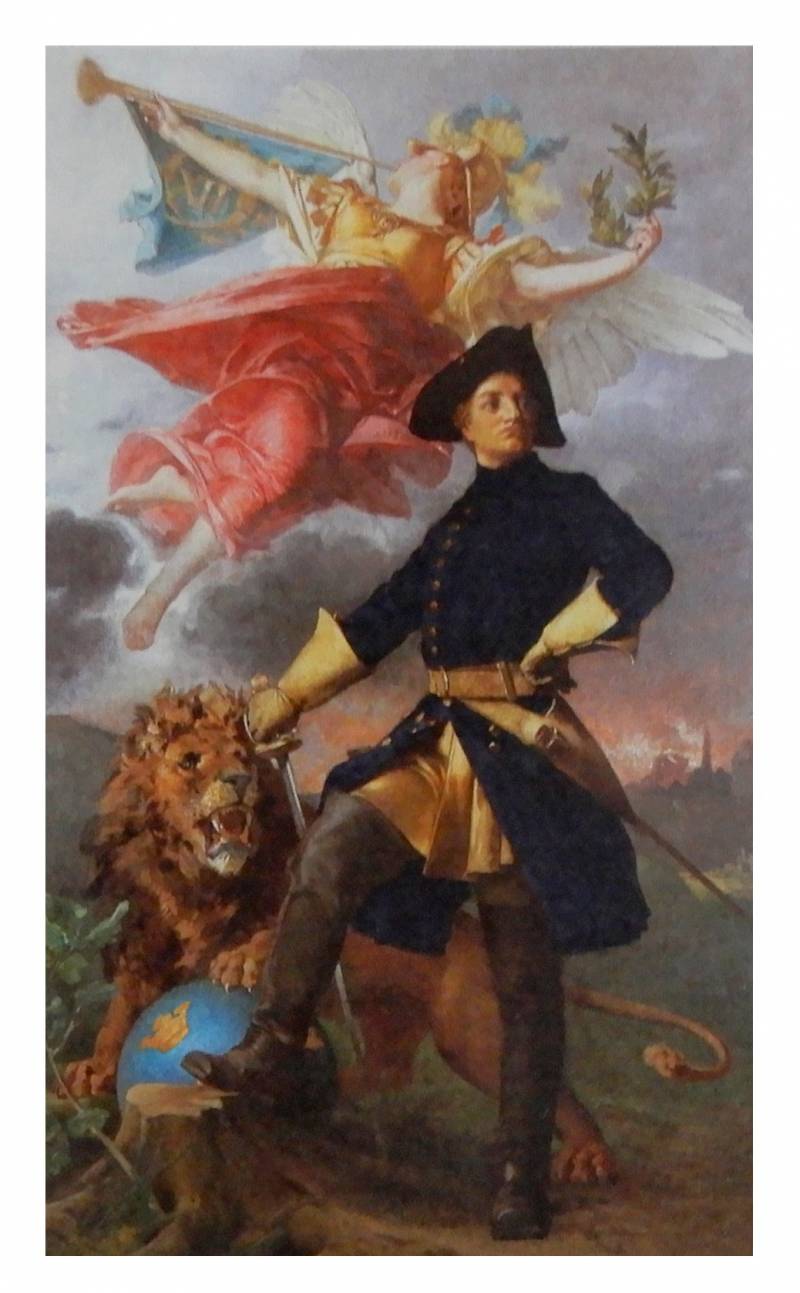
Charles XII. Hood. D. Kronberg, XIX century.
Today, many are wondering how such a huge country as Peter I’s Russia waged a war against “little” Sweden for twenty-one years?
But, firstly, Sweden was the hegemon of the Baltic. Peter joined the alliance that was created by the elector and king of Saxony and the Polish-Lithuanian Commonwealth Augustus II the Strong, who initiated the war and attracted a strong maritime country, Denmark, to the alliance. And Sweden, in addition to the navy, had a professional army, which outnumbered the armies of Denmark and Saxony, without the Polish-Lithuanian Commonwealth, combined.
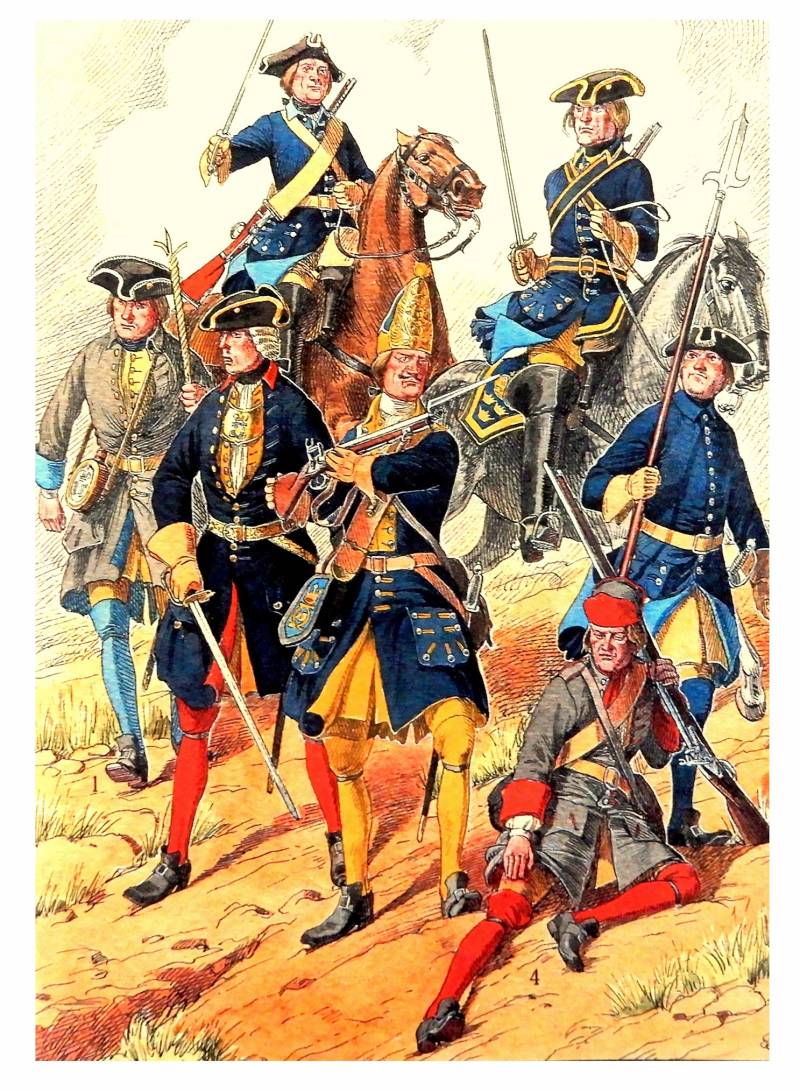
Swedish Army units 1699–1709 Hood. O. Parkhaev.
The Russian army, although it was significantly larger than the Swedish one, required serious modernization. The country's borders did not allow it to be used entirely in the Swedish Baltic states.
Thirdly, any state in the medieval world was created along the path of war, and Russia was no exception. Gradually, with modernization, the capabilities of the Russian army and navy grew. It would be more correct to say that modernization began to work exclusively for these purposes.
As a result of incredible efforts and titanic work, the Russian army inflicted a crushing defeat on the Swedish army in the Battle of Poltava in 1709. Peter came to this victory naturally, through defeats and difficulties, of which there will be many more, and there will also be serious failures, as in the war against Turkey. As a result of the Poltava victory of Tsar Peter, the balance of power changed not only in the Northern War, but also in Europe.
Russia became the hegemon of Eastern and Northern Europe, and Karl turned from a “lion” into a “Delhi Bey” (mad ruler), as the Turks called him, where he fled with the Little Russian hetman-traitor Mazepa, who was counting on the victory of the Swedes.
For one reason or another, the war lasted until 1721. And it ended in a crushing defeat for Sweden, which nevertheless received back Finland, as it was unnecessary for Peter, and payment for the Baltic states.
What happened? Speeding up with a whip
Peter, in the course of his reforms in Russia, created everything almost from scratch: from factories to the fleet, from the modern monetary system of his time to new taxation, changed the customs and the very rhythm of life, especially of the noble class.
I repeat that historiographical, and behind them amateur, attempts to believe that Peter’s reforms were a continuation of the reforms of his father Alexei Mikhailovich (1629–1676) and brother Fyodor Alekseevich (1661–1682), sister Sophia (1657–1704), are only partly correct , since, as during the period of modernization in Turkey and Persia, they were of a superficial nature and did not affect the foundations of society, and therefore did not leave a significant mark on the development of society: as they came, so they left.
The army and navy required rapid improvement, but it was impossible to launch factories in an instant, and what was left of the previous renovation was unable to provide for either the army or the country without modernizing them in turn. Mass purchase of small arms weapons abroad occurred before 1710, and the cold one even in the second decade of the XNUMXth century. With the entry into operation of the Olonets factories and the modernization of the Tula factories, the need for imported small arms disappeared.
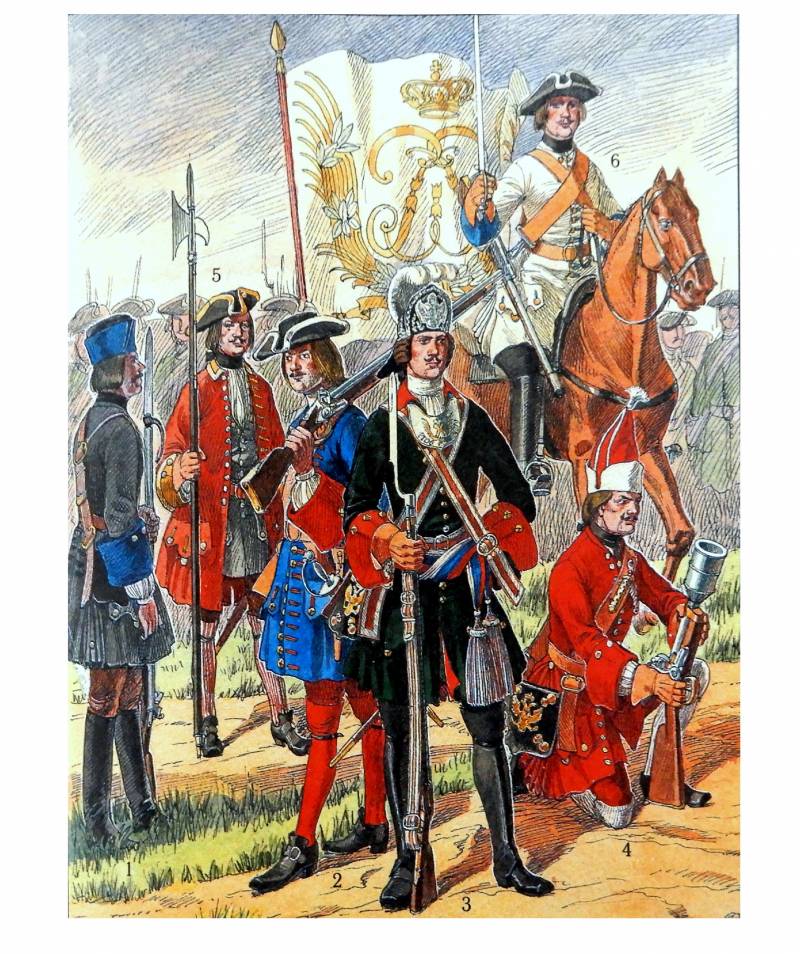
Russian army in the Northern War. 1704–1712 Hood. O. Parkhaev.
The same situation was with cloth, and with cloth enterprises (70% of imports), and the supply of metals from Europe. It is difficult to list what was supplied to Russia: salt, paper, books, ship models, coal, military equipment and ship equipment, tools and machines, etc., not counting the specialists who either set up new production facilities or carried out maintenance and repairs imported, for example watches.
Most of the manufactories, the construction of which was launched by Peter I, both through Russian and foreign merchant-industrialists, and at state expense, came into operation by the end of the Northern War and the end of the Tsar’s reign. And they will begin to bring results from the 40s, not without the participation of the current government, like this: 50% of the cloth for the army under Anna Ioannovna was already supplied by Russian manufactories. All these modernization actions of Peter, practically from scratch, led to victory in the Northern War for Russia, our country, which was then at an earlier stage of historical development than the loser.
If Peter’s grandfather and father carried out targeted modernization, then Peter carried it out comprehensively, improving primarily the upper class of the country, which made the results of modernization sharply more stable and created a foundation for the future. It also turned the ruling class of feudal lords into a kind of “Europeans.”
Advanced European innovations were able to take root on Russian soil, for example: scientific institutions, collective management systems, the Senate, Collegiums, industry and mining, and finally, the modern structure of management and construction of the army and navy.
But... without constant European replenishment, these structures could not work adequately then, because they were imported, and not natural, as in other European countries, where the countries there arrived at these achievements through evolutionary means. Because all these innovations were carried out in our country of early feudalism, and not in the state of early capitalism or late feudalism, from where they were borrowed.
I would not like readers to have the opinion that only Russia borrowed; Russia’s neighbor, the Polish-Lithuanian Commonwealth, constantly made technological borrowings at that time. All countries borrow technologies and institutions, but we are not talking here about Russia borrowing something, but about why this happened and how it was related to the social development of our country.
Through the cut window
After Peter’s reforms, we did not see any over-activity of Russian merchants in international trade markets.
Despite the fact that the volume of factory production in Russia has increased significantly, nothing new has been proposed for export. The same industrial products or raw materials remained in use. There could be no talk of any increase in the mass product necessary for foreign trade. And our merchants are becoming not independent players, but intermediaries, agents between foreign merchants and the Russian market, as was the case before. Because feudal Russia could not sell anything other than raw materials.
The attempt to achieve transit from the East to the North failed; the captured lands in Persia became “a suitcase without a handle” for the emperor’s heirs. As we wrote above, objectively for Russia, the path in the opposite direction was more important; the country widely opened its markets to Western goods.
The price of reform
Modernization together with the war, and here we are witnessing the mutual intertwining of events that cannot be separated, required colossal resources. From 1680 to 1724, the amount of direct taxes, taking into account the depreciation of the ruble, increased by 3,7 times, and total taxes - by 2,7. This caused the flight of peasants, the growth of numerous bandits of robbers who robbed noble property, and the Bulavin uprising of 1709.
On top of that, in 1723–1724. There was a crop failure and famine, however, all-European in 1724. Because all this, of course, was the price of reforms. In search of a solution to the problems to ensure modernization, tax reform was carried out in the fight against tax evaders. She transferred the object of taxation from the yard to the taxable person.
Comparison of household collection data for 1721–1723. to the poll 1726–1727 shows that for all categories of tax workers who paid additional taxes before the reform, the amount decreased (from 8 to 21%), and for landowner peasants who did not have additional payments, it increased by 62%.
Russian society, and especially the Russian peasantry, which became a serf, feudal-dependent class, lived in conditions of constant mobilization throughout the XNUMXth century. With the beginning of the XNUMXth century, this situation only worsened, since total modernization required dramatically greater resources and efforts.
The ruin of peasant farms, and after them the nobles, was caused by the overstrain of the country's economic forces during the war and the work of the primitive agrarian economy, in conditions of risky farming, at the limit of its capabilities.
Revolutionary on the throne?
It is often written in scientific and journalistic literature that Peter, having created a regular army, put on the same line both the serf recruit (slave) and the nobleman, who began their service as privates. But such a situation occurred only during a short period of intense struggle with an external enemy, when it was urgently necessary to increase the army. Peter the “revolutionary” did not change any social structure of society, and he introduced such an order for “pedagogical purposes”: to educate “soldiers” from the nobles who knew military craft from the very beginning, like himself.
Victories in the wars, in which both Russian classes and other class groups participated, brought benefits primarily to the ruling class, introducing it not only to modern military technologies, but also to the material world of Europe.
At the end of the 1682th and beginning of the 1723th centuries, the iconic elements of pre-class society were destroyed: tribal localism (XNUMX) and servitude (XNUMX). In comparison with the previous period, the feudal class, like the peasant class, took on a clear structure: the tax-paying population included everyone who did not have an officer rank, did not serve in the service, was not descended from Moscow officials, and did not have serfs. The “Table of Ranks” on the feudal soil of the XNUMXth century documented this situation, denying access to the ranks of the nobility to commoners.
It reflected the hierarchical structure that developed among the nobility in the XNUMXth century depending on the size of land ownership.
The development of this feudal hierarchy will lead to the fact that from the 60s only wealthy nobles will be able to serve in the guard. Of the 400 thousand former ordinary servicemen (small feudal lords) in 1730, 340 thousand were transferred to state peasants, and 60 thousand to townsmen. The isolated facts that among the tsar’s entourage there were people from different classes do not make Peter a democratic tsar. In general, through his actions, directly or indirectly, he contributed to the strengthening of the feudal class as the dominant one, standing above the urban class and the peasant class.
The nobility as a military class, with many excesses associated with service and its hardships, was the driver in governing the country and in war; war was a natural job for it.
The Europeanization of the nobility: face shaving, European uniforms and clothing, European fashion and, finally, the use of a different language marked the beginning of a sharp division between the two classes, as, indeed, in many early feudal states, for example, as in England after the Norman Conquest. This caused a huge gap between the classes.
The beneficiary of the modernization of the country and the victory in the Northern War, if you do not take into account historical The perspective that was extremely important for the future of Russia was exclusively the class of nobles.
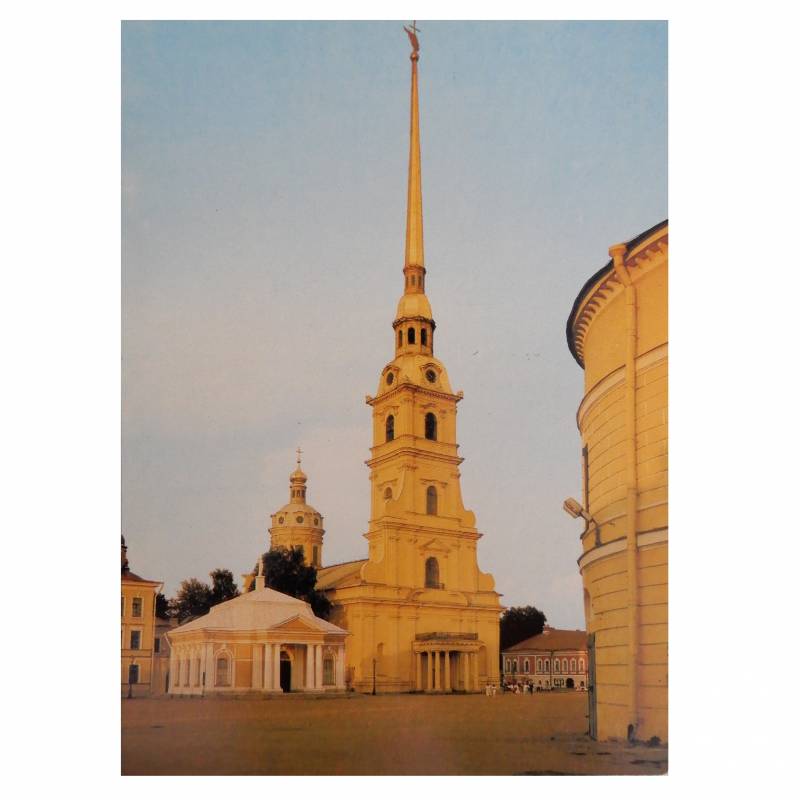
Peter and Paul Cathedral. St. Petersburg. Architect D. Trezzini. 1712
External pressure in the form of fashion and material wealth pulled Russian feudal society into the world of commodity-money relations and led to increased exploitation of the feudal-dependent population throughout the XNUMXth century. Pososhkov defined the situation very clearly:
As a result of Peter's modernization, next to it and as a consequence of it, the feudal system only strengthened. He was reliably protected from external influences and entered the stage of “high feudalism”, with the only difference being that the “knight of the XNUMXth century” had modern small arms and corresponding control technologies in war.
The nobility clearly realized its role in the process of governing the country at all stages from police to ... the search for minerals and even trade, especially in the armed forces. And the peasants, dependent on the nobles, began to be actively used not only in agricultural fields, but because of the “military revolution” and on the battlefields.
It is naive to believe that if the Russian army became “regular” under feudalism, then its social essence changed. The situation in Russia clearly emphasizes the dominance of the system over management structures.
During Peter's modernization and simultaneously with it, a society emerged to which the formula of feudal Europe of the XNUMXth–XNUMXth centuries can be applied. about those fighting, plowing... and praying.
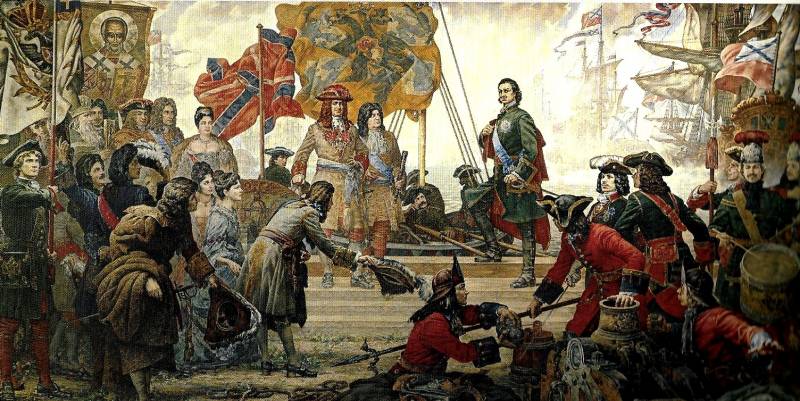
Information